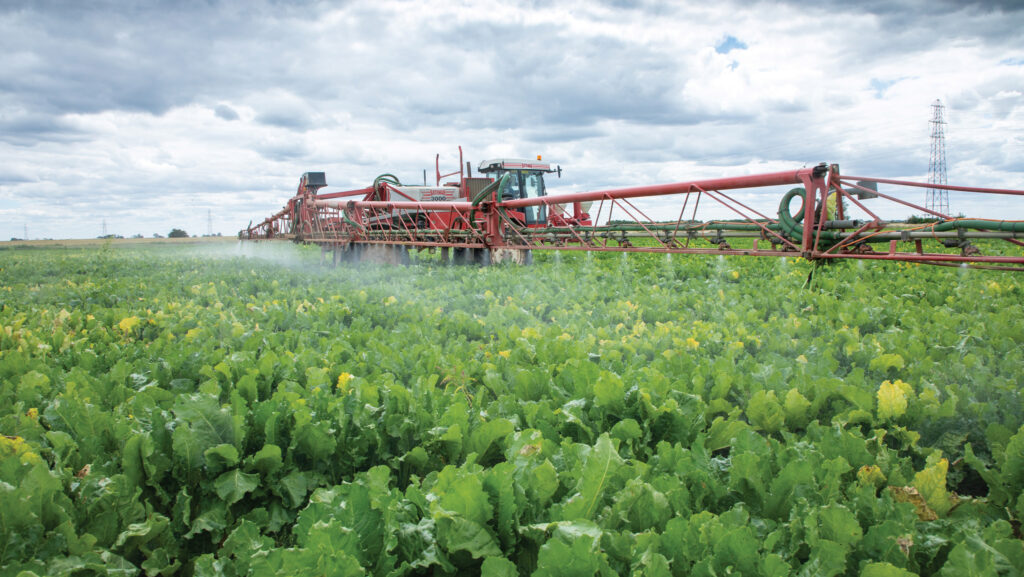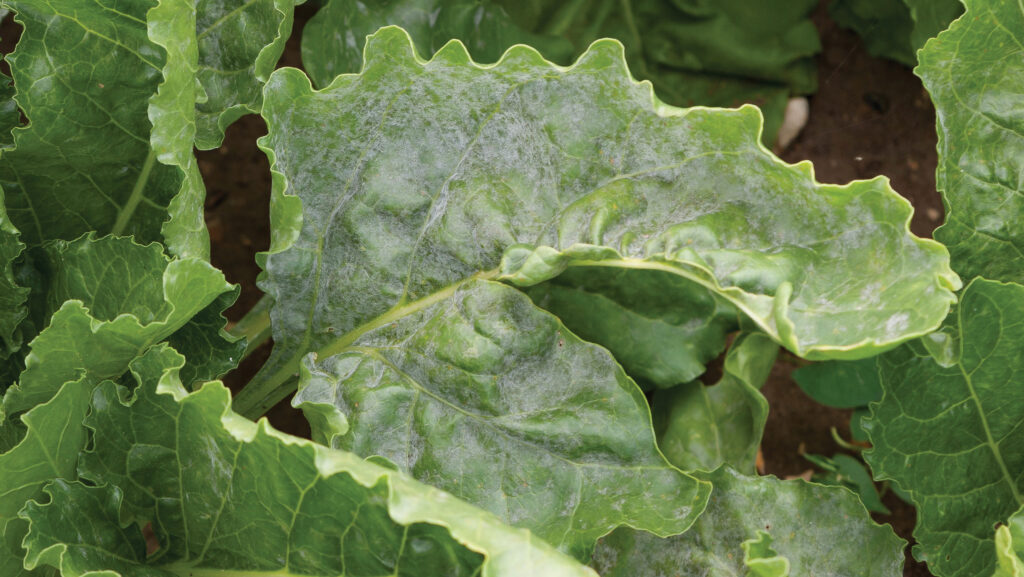Tips to tackle foliar sugar beet disease in high risk season
 © GNP
© GNP Virus yellows is not expected to be the major issue feared in the spring – when aphid migration started earlier than usual – sugar beet growers have been reassured by the British Beet Research Organisation.
However, the mild, wet conditions means there have been other challenges getting the crop established and foliar diseases are “ready and waiting”, with powdery mildew expected to show first due to a lack of over-winter frosts.
See also: After 80 years, where next for Recommended List?
“It’s encouraging that the majority of the sugar beet crop has established well, but the season has not been without its difficulties and growers must be prepared as we move into July,” notes Prof Mark Stevens, head of science at British Beet Research Organisation (BBRO).

Powdery mildew is predicted to be a challenge in sugar beet © Blackthorn Arable
Sugar beet crop 2024-25
- Crop area 102,000ha
- Drilling date average 7 April 2024
- Crop progress 85% of crop at 6 true leaves or greater
- Herbicide use Some effect on plant populations on lighter soils where herbicides moved to the root zone
Source: British Sugar
Aphid activity
Despite aphids arriving during the third week of March – as they did in 2020 – the subsequent windy and cold weather has suppressed their activity and the presence of moisture means crops have grown well.
“We were anticipating that aphids would arrive around 10 April,” he reports.
“So we were nervous when they were recorded in March, as that echoed what had happened in the terrible year of 2020.
“Although the first virus symptoms are just being reported in commercial crops and we know that’s taking place in France too, we are less concerned than we were.”
Foliar disease
The good news is that there hasn’t been any early foliar disease reported, he adds.
“There is some bacterial leaf spot in crops in East Anglia, which can be confused with cercospora, as the symptoms are very similar. But don’t apply fungicides for that.”
Mark expects to see powdery mildew first, following such a mild winter.
“This needs managing as soon as you see it so check any susceptible varieties. It looks like talcum powder over the leaves.”
He adds that foliar diseases do not come in isolation. Rust takes advantage of cooler conditions in August, September and October, while cercospora leaf spot must be taken seriously.
Climate change
“We know that our changing climate conditions favour it, and broad-spectrum fungicides are critical for its control.”
Look for small black lesions, advises Mark. “The key with sugar beet is to maximise the canopy and keep it healthy – up to 40% of yield potential is gained from September onwards.”
For cercospora to develop, humidity and leaf surface wetness must be present. “If moisture is there, then temperature will drive it. You need them together.”
Neonicotinoid alternatives
The use of colours to confuse aphids and odours to repel them are among the alternative approaches being investigated by British Beet Research Organisation (BBRO), as ways of replacing neonicotinoid-based seed treatment.
As aphids are attracted to the contrast between brown and green, changing the spectral reflectance between the soil and plant may help to reduce that attractiveness, suggests BBRO’s Mark Stevens.
“We’ve used blue, green and red dyes and sprayed them onto the soil in our plots, with aphid numbers falling by 50%.
“We now need to crunch the data to see if that has reduced virus levels.”
In a similar way, a French product, known as Agriodor – which contains natural fragrances and is designed to influence pest behaviour – has been applied to see if it repels aphids.
“Again, we are seeing some initial results that indicate a 50% reduction in aphid numbers, which could delay the first spray by about 10 days,” notes Mark.
“It seems to push the aphids away and suppress their build-up.”
Work will continue on both techniques, with other mitigations also being investigated.
Seasonal challenges
Norfolk-based independent agronomist Craig Green says that sugar beet is a different challenge this year.
More free-living nematode damage has been seen on light land, and heavy rain is responsible for some herbicide damage.
“In contrast, we had a 40-day drought in May/June last year, which the crop coped with well.”
Craig adds that although there’s been no drought stress so far this season, he is anticipating a high disease year as humidity levels rise.
He set up a light land trial last year to look at cercospora control, testing two spray fungicide programmes.
The first treatment was Priori Gold (azoxystrobin + difenoconazole), followed by either another Priori Gold, Revystar (Revysol + Xemium) or Caligula (fluopyram + prothioconazole) application four weeks later.
“The planned third spray didn’t happen – it was just too wet in October,” he says.
The standout product was Revystar, he confirms, applied at 1 litre/ha in 150 litres of water, for its ability to keep the canopy green and healthy. It also raised sugars slightly.
“My main learning is that I would prefer to use Revystar first in the programme, as it has a harvest interval of 28 days. Caligula has a much shorter restriction.”
Revystar in sugar beet
Revystar XE is a preventative fungicide which is active against all the key diseases in sugar beet, claims Iain Ford, business development manager at BASF.
It can be applied twice in a season, has a 28-day harvest interval and does have some rate flexibility, he adds.
“For rust, powdery mildew and ramularia, you can use 0.8 litres/ha.
“But for cercospora, that should be increased to 1 litre/ha, or you won’t get the longevity of control.”
Two trials conducted with British Beet Research Organisation, in 2022 and 2023, showed that a two-spray programme with Revystar gave better disease control, helping crops to maintain canopies and withstand frost when it arrived in December.
Giving a margin over fungicide cost of £767/ha, more than £130/ha compared to the next best programme, it also increased yields and sugar content, he reports.
Crop experts shared their expertise with Farmers Weekly in a BASF-organised webinar entitled “Mastering disease control in sugar beet”.

